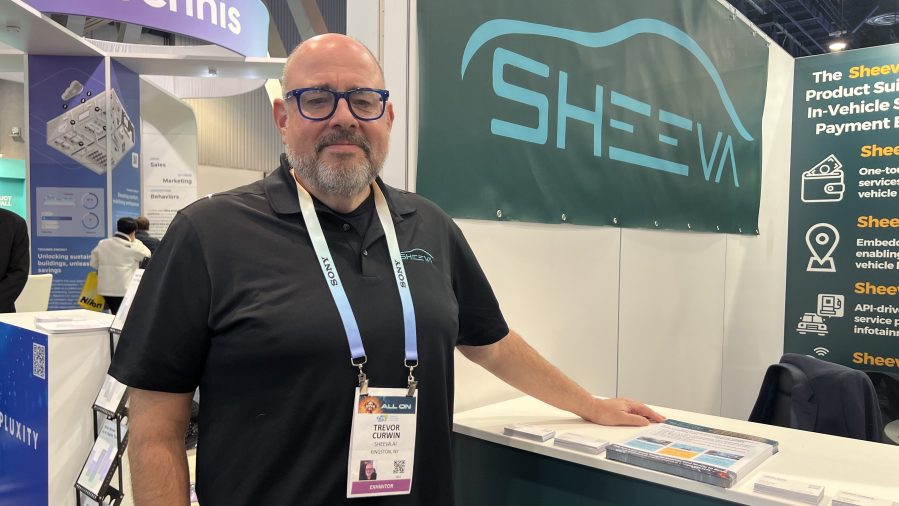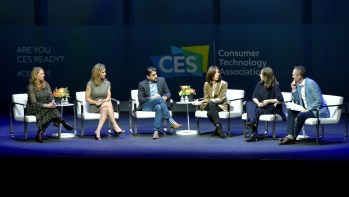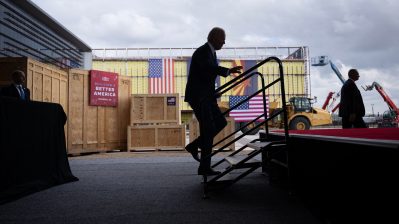At CES, a look down the long road ahead for automotive tech

CES is many things. It is perhaps best known as an annual gadget fest, a glimpse into the kind of technology we might be using a month from now or even a decade from now.
That applies to vehicles too. Here at CES, being held this week in Las Vegas, you will find one of the biggest auto shows on the planet, which is why it’s worth noting that General Motors, Ford and Chrysler aren’t here this year.
The United Auto Workers strike ended just a few months ago. General Motors, specifically, is still regrouping after the implosion of its robotaxi startup Cruise. Meanwhile, Tesla’s Autopilot driver assistance is under pressure from regulators.
The idea of reaching fully autonomous driving — what’s known as Level 5 in the tech sector — is starting to feel out of reach. And maybe that’s OK.
Marketplace’s Lily Jamali spoke to Trevor Curwin, director of strategic partnerships at Sheeva.AI, an automotive payments company, from the CES floor about the troubles and outlook for the auto industry’s tech ambitions.
The following is an edited transcript of their conversation
Trevor Curwin: Where we are now when we say “Level 5 autonomy” — that’s [when] you can go to sleep in the back seat and you don’t have to worry about the car getting [lost] somewhere — where we are right now, depending on who you ask, we’re either somewhere between Level 0 and Level 2, depending on the car.
Lily Jamali: So miles away from Level 5.
Curwin: We have a long way to go. And I think the question that needs to be asked about that is how much autonomy is enough? For us here at Sheeva, we’re doing in-vehicle payments that is location based. So we’re a software layer that is involved in the things that a connected car can do for the driver to improve the driver’s experience. If you think about wherever we are between Level 0 and Level 2 autonomy, that means there’s a whole lot of things that are being brought into your car that you didn’t have before — lane assist, adaptive cruise control. There’s a lot of little bits of technology that are being integrated into the car as it is. So then you have to say as a driver, “Do I care about whether I can go to sleep in the back seat? Do I need Level 5?”
Jamali: Maybe I don’t need it?
Curwin: And maybe you don’t. And then the other problem is outside the car, what happens? Cities have to come up with rules. This is why Cruise was an issue in San Francisco. Cities have to come up with rules in a world where there’s a lot of human-driven vehicles still and autonomous vehicles. So what are we going to negotiate those two worlds at? I don’t know, does it have to be Level 5 autonomy? I’m not sure.
Jamali: How do you answer that question? Do we need Level 5 autonomy?
Curwin: I don’t think it’s something that’s necessarily needed right now or for, you know, maybe for another decade, in terms of how we interact with our cars. Don’t forget, there’s a lot of consumer behavior that goes with a car. Again, we know it here at Sheeva, where we’re trying to get people to adapt their existing consumer behavior to the new digital world around them in a car. When we think about Level 5 autonomy, you’re asking a big jump really, for people to be able to fall asleep in the back seat. I think drivers [will] just take some time to adapt to it. And so it will happen probably, but it’ll be some time.
Jamali: And your business thrives in a more semi-autonomous world. So I want to ask, what are you hearing from customers in terms of what they want? And what are you guys doing to deliver that?
Curwin: Well, honestly, we can adapt to a fully autonomous world too because then you can do all the retail purchases you like from your car and have them paid for then in the car. One of the main things you see — I believe it was a recent JD Power research report asking several thousand drivers what they wanted to get out of their connected car, what are the additional benefits they wanted to get from their connected car versus the older, unconnected car they might have had before? The main thing they always ask for is parking — “Help me find parking, help me navigate the parking, help me pay for parking.” I mean, that’s one thing we do here, you pay for it from inside the car.
Jamali: Parking is always a problem.
Curwin: Yeah, and that’s the reality, right? The first things you’re going to want to achieve are, let’s call them car-related tasks: fueling, charging, parking, curbside pickup, things like that. You’re going to want to do them from inside the car because you can use the platform.
Jamali: So last year, you and I had a conversation about mass adoption of EVs, and you were trying to convince me — and you actually did a pretty good job of this — that we were a lot closer to mass adoption than a lot of us thought. 2023 was a little bit of a rough year for EVs. Do you remember that conversation?
Curwin: I do remember that conversation.
Jamali: And what was your prediction?
Curwin: I probably, only because I know I’ve said it a million times, said something to the effect of everybody says by 2035, every new vehicle will be an EV pretty much. And we probably get there faster. I haven’t changed my opinion on that. Now, I hear what you’re saying. There’s been a lot of headlines about automakers moving in and out of, or automakers adjusting their EV strategy. And now what we’ve seen from incumbent automakers is “This may not have been as easy to do as we thought.” And so they’ve got to figure out whether it’s on a model basis, on a brand basis, whatever the issue is with their production infrastructure, to make it happen. It might be a little bit rough. There’ll be some bumps.
Jamali: Sure, sure. But looking back at 2023, it seemed like we had a moment, right, where EVs had a lot of interest from consumers but the support just wasn’t there, in terms of charging especially. The charging infrastructure did not deliver. So how big of a rethink do we need when it comes to things like EV charging?
Curwin: So EV charging, it’s a challenging world because the existing charger networks we’re more familiar with if you drive around and then charge a car — I have a plug-in hybrid myself, I’m familiar with the challenges. There’s a lot of issues around maintenance, you have hardware out in the wild, you know, people run into it, bad weather.
Jamali: And what makes it so hard? Is it the fact that there’s so many different players involved? It’s not just a gas station owner, it’s not just the EV maker.
Curwin: What effectively changed here from a gas-powered car to an electric car [was] the consumer behavior of going to an energy store, quote-unquote, to get energy for your car and then leaving that energy store. You can actually break those things apart. And of course, [there are] other big retailers who wants your attention too. “Hey, come here, we have electricity. We’re Target, we’re McDonald’s, we’re Starbucks. Hey, you got to park here anyway, while you’re coming in [and] doing some shopping. Plug in and charge up.” They might look at that as a customer-acquisition cost. If you’re the utility, if you’re [Pacific Gas & Electric], or [Consolidated Edison] or whoever it might be in your local area, they look at it as well, “We enable the delivery of electricity. EVs are another giant new appliance in everybody’s driveway that consume electricity. We want to get a handle around how we manage the power grid around those.” And then for automakers, it’s a brand extension, it’s “Talk to us every day about your consumer needs, not just once every five years when you do a purchase of a car.”
Our time at CES is just beginning.
We’re here all week, and our schedule is packed with demos on everything from sleep tech to age tech. There are plenty of quirky things to see here.
I’ve already made my first AI friend. The AI-powered cat door caught our eye as did the voice-controlled bidet. Ah, toilet tech — it never gets old.
Our show is taking over the Marketplace Instagram account while we’re here at CES, so make sure to follow us there to see what we’re seeing!
The future of this podcast starts with you.
Every day, the “Marketplace Tech” team demystifies the digital economy with stories that explore more than just Big Tech. We’re committed to covering topics that matter to you and the world around us, diving deep into how technology intersects with climate change, inequity, and disinformation.
As part of a nonprofit newsroom, we’re counting on listeners like you to keep this public service paywall-free and available to all.
Support “Marketplace Tech” in any amount today and become a partner in our mission.


















